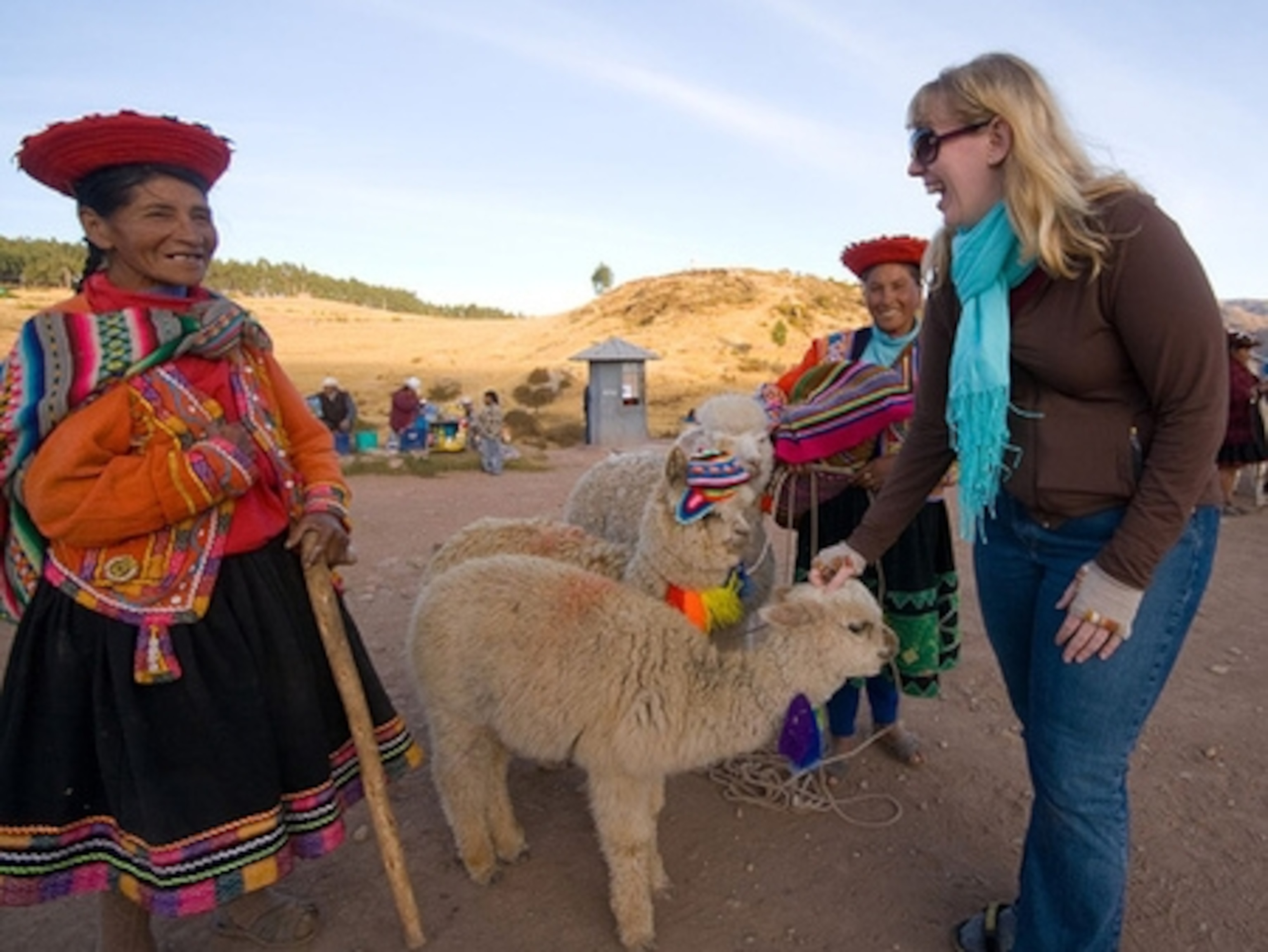
Peruvian Knitting Quest
As the East Coast temperatures begin to drop, IT staffers want nothing more than to sip hot tea by a roaring fire and bundle up with warm wool sweaters and scarves. Our yearning for yarn sparked an interest in one knitting blogger who recently traveled to Peru to learn more about the country’s ancient textile traditions.
Lauren “Lolly” Weinhold (pictured) author of Lolly Knitting Around, blogs about her recent Peruvian adventure in “A Way of Life.” She writes,
“Before traveling to Peru, I did not completely understand how the fiber arts could play such a large role in a culture—not as a hobby—but more as a livelihood and a deep-rooted tradition. I knew about the Peruvian weaving techniques, the knits and the crochet, and a little about the spinning. Reading about these things in glossy travel magazines is one thing; yet seeing the fiber arts in action is definitely another thing all together.”
Southeast of Lima in the Incan capital of Cusco, people can be seen working with textiles everywhere. Lolly describes a young schoolboy, in nearby Chinchero, using his backpack to hold his skeins of yarn; women stopping on the side of the road to knit mantas (women’s capes) and clothes for their children; she even saw a man knitting a chullo using bicycle spokes. The ancient tradition of working with alpaca, wool, and llama (baby llamas are often praised for their warm fleece), is unlike that of any other country.

One of the best places to learn about Peruvian textiles is the Center for Traditional Textiles of Cusco. The nonprofit museum, founded in 1996, focuses on the rich textile traditions of the Cusco region of the Andes. The museum features textiles from nine communities: Accha Alta, Acopia, Chahuaytire, Chinchero, Chumbivilcas, Mahuaypampa, Patabamba, Pitumarca, and Santa Cruz de Sallac. Handwoven garments are also sold in the center’s store, where each is labeled with information about the Cusqueñan weavers, including the name, birth date, location, and even a photograph of the weaver. Proceeds from the items sold go directly to the families that made them.
Thanks, Lolly, for your awesome post! Learn more about authentic handicrafts in Peru with Traveler‘s Authentic Shopping Guide.
Related Topics
Go Further
Animals
- This ‘saber-toothed’ salmon wasn’t quite what we thoughtThis ‘saber-toothed’ salmon wasn’t quite what we thought
- Why this rhino-zebra friendship makes perfect senseWhy this rhino-zebra friendship makes perfect sense
- When did bioluminescence evolve? It’s older than we thought.When did bioluminescence evolve? It’s older than we thought.
- Soy, skim … spider. Are any of these technically milk?Soy, skim … spider. Are any of these technically milk?
- This pristine piece of the Amazon shows nature’s resilienceThis pristine piece of the Amazon shows nature’s resilience
Environment
- Are the Great Lakes the key to solving America’s emissions conundrum?Are the Great Lakes the key to solving America’s emissions conundrum?
- The world’s historic sites face climate change. Can Petra lead the way?The world’s historic sites face climate change. Can Petra lead the way?
- This pristine piece of the Amazon shows nature’s resilienceThis pristine piece of the Amazon shows nature’s resilience
- Listen to 30 years of climate change transformed into haunting musicListen to 30 years of climate change transformed into haunting music
History & Culture
- Meet the original members of the tortured poets departmentMeet the original members of the tortured poets department
- Séances at the White House? Why these first ladies turned to the occultSéances at the White House? Why these first ladies turned to the occult
- Gambling is everywhere now. When is that a problem?Gambling is everywhere now. When is that a problem?
- Beauty is pain—at least it was in 17th-century SpainBeauty is pain—at least it was in 17th-century Spain
Science
- Here's how astronomers found one of the rarest phenomenons in spaceHere's how astronomers found one of the rarest phenomenons in space
- Not an extrovert or introvert? There’s a word for that.Not an extrovert or introvert? There’s a word for that.
- NASA has a plan to clean up space junk—but is going green enough?NASA has a plan to clean up space junk—but is going green enough?
- Soy, skim … spider. Are any of these technically milk?Soy, skim … spider. Are any of these technically milk?
Travel
- Could Mexico's Chepe Express be the ultimate slow rail adventure?Could Mexico's Chepe Express be the ultimate slow rail adventure?
- What it's like to hike the Camino del Mayab in MexicoWhat it's like to hike the Camino del Mayab in Mexico